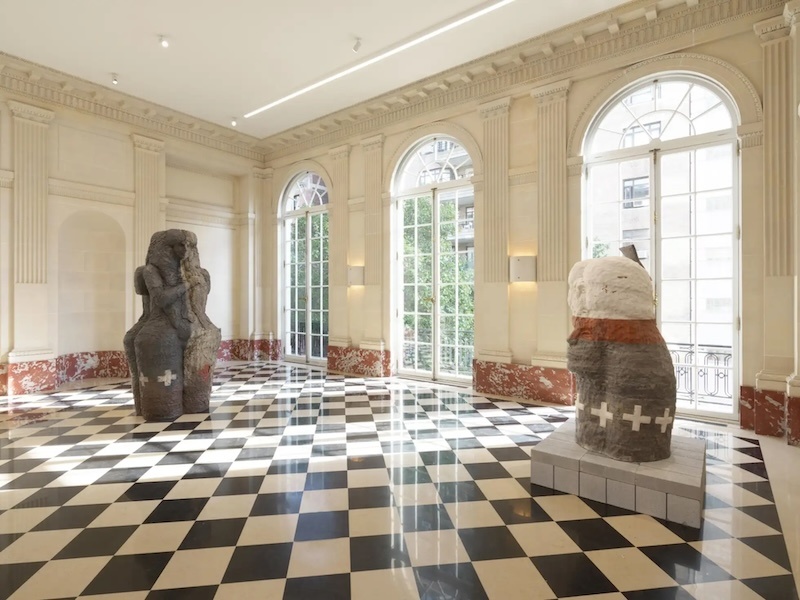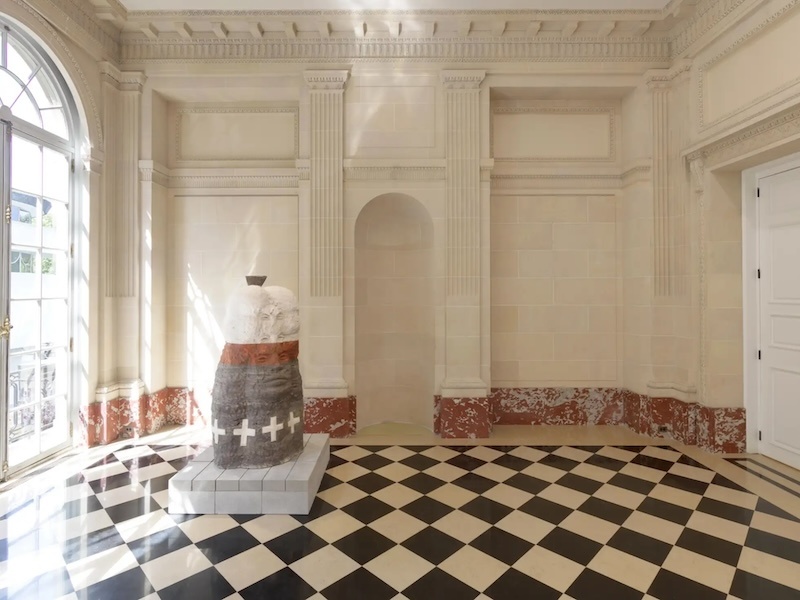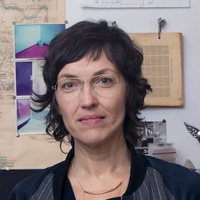On being true to who you are
Prelude
Raven Halfmoon is a sculptor based in Norman, Oklahoma. She is part of the Caddo Nation, and much of her artwork is reminiscent of tried practices and symbologies often recognized by her tribal ancestors, with her own contemporary twist. Halfmoon is interested in representing the strength of the matriarchy and creates new totems of sorts in honor of the lineage of strong women in her life. She uses stoneware, and has newly introduced bronze into her practice. NEESH + SOKU (MOON + SUN), her solo exhibition at Salon 94, is her first with the gallery. It features two new works in particular that are examples of her expanding practice and exploration of different materials. One such work, “Dancing at Dusk” (2024) is made of three different colored tonalities of travertine, a stone native to the midwest, while “The Guardians” (2024) is bronze patina and stands nine feet tall.
Conversation
On being true to who you are
Visual artist Raven Halfmoon discusses finding your voice, being inspired by community, and leaving a mark.
As told to Katy Diamond Hamer, 1396 words.
Tags: Art, Identity, Beginnings, Success, Process.
Before we get into the show, can you talk a little about yourself?
I grew up in Oklahoma, a citizen of the Caddo Nation. However, I’m also Choctaw, Delaware, and Otoe. Both my mom and dad on both sides of my family are native. My entire family is pretty big and my dad works with the chief of the Cherokee Nation and does all of their public relations. My mom has been a museum director and helped open cultural centers, so we’ve always been tied to our community which is really important to us. So this [trajectory] has been a natural continuum for me. I’ve been making art for as long as I can remember and even in preschool, when they asked what I wanted to be an Artist. Always an artist. My family always pushed me to create and make and have been super supportive throughout this journey.
What brought you to stoneware as a medium?
I was thirteen years old when my mom took me to see tribe elder Jeri Redcorn who really revitalized traditional Caddo pottery. We went to her house and made pulled clay and pit fire to make traditional pots with material basically out of a river bed. I took that traditional knowledge with me to the University of Arkansas where I took anthropology courses about my own tribe—they are one of the original tribes from Arkansas. I have a Bachelor’s degree in Anthropology and Studio Art. So all of my interests have meshed together. I like to take inspirations that are more than just the self, looking at community. I get compliments on this, but people say the work looks like it could be made now, or thousands of years ago. They’re timeless, which is exactly what I’m going for.

Installation view, Raven Halfmoon, Neesh + Soku (Moon + Sun), 2024, Image courtesy of the artist and Salon 94. © Raven Halfmoon, Photo: Elisabeth Bernstein.
Can you talk about how you’ve made work using all of these historical layers all your own?
It’s definitely been about finding your voice out here in the world of millions of voices. It’s been tough, but also a blessing and I feel a huge responsibility to do everything right. One thing I’ve learned being an artist is that to just be true and genuine to who you are and your experiences and that is all I’m doing within the work. All my work features women, as I try to stick to what I know, what I’ve been through. A lot of it is about my grandmother’s and great grandmother’s stories and of course that also includes my ancestors. I feel like the work is very holistic, and there are so many people behind me helping me make it.
That’s really beautiful.
Thank you. I had one of the rooms in the gallery (on the 2nd floor) in my sketchbook where I took pictures of other shows and said, “I’m going to be there one day.” and I printed out the pictures and inserted my own pieces into the space collage style. I wrote in 2024, “Salon 94 Raven Halfmoon,” and it’s so crazy because four years later we are here.
You manifested it!
I know, and I actually just got that [word] tattooed on my wrist.

Installation view, Raven Halfmoon, Neesh + Soku (Moon + Sun), 2024, Image courtesy of the artist and Salon 94. © Raven Halfmoon, Photo: Elisabeth Bernstein.
Can you talk a little bit about your process? Some of the new work is really massive.
Yeah, we are already in about two years with these. Process wise these two, “Dancing at Dusk” and “The Guardians” (both 2024), were started with a sketch. I always sketch everything out. I know how I want to place the form and I have an idea of how I want to glaze them, patina, or particular color palettes I want to use. With “The Guardians,” I did a nine foot tall drawing that functions as an outline that I put on the wall. It’s all coil built and sitting clay and still at United Artist Projects (UAP) in Upstate New York. We are trying to figure out how to fire it because it was built out of clay and is sitting there (the clay was used to make a mold for the finished work which is in bronze) and they sand casted it and we have an edition, but there is no kilns that are nine feet tall. They told me she might even break from casting, but she popped out perfectly which made me think, it’s a sign!
With the stone piece, “Dancing at Dusk,” I went to Arkansas for a residency, and I built the work out of clay and she is about three feet tall. So we’ve scaled the sculpture up double the original size using machine CNC Router [laser carving]. We were in conversation about possibly using marble, but I wanted a stone that was from the United States and closer to my history. I wanted a stone that spoke to the same language as the clay that I use. The stone has a sealant on top so that it can go outside. Getting to this point where I have a team that can help me with my vision has been so nice because it’s a moment for me to let go, which has been hard. It’s like having someone else taking care of your babies. But admitting that I didn’t know how to carve travertine, was part of the process. Giving power to the tools that help you build is something I really like.

Installation view, Raven Halfmoon, Neesh + Soku (Moon + Sun), 2024, Image courtesy of the artist and Salon 94. © Raven Halfmoon, Photo: Elisabeth Bernstein.
What is your relationship to painting and mark making?
I have five foot by five foot canvases that I’m stretching right now in my studio. And the gesture of scale and movement is in my paintings as well—very bold, very big. When I first started working at this scale in sculpture, I started to think of the work as 3D drawings. Knowing how I would paint them, too…they feel like a painting in the round. From taking my practice from 2D to 3D the figures feel like beings, where sometimes my paintings don’t feel as powerful, it might be just me, but I like how sculptures have a relationship to us; us, as in being 3D and volumetric. Sculpture lends itself to perspective to where you stand in space.
When I went to The Met years ago for the first time, I saw Van Gogh’s work, in person and not just in my art history classes. Seeing his bedroom and some of the flower pieces that are in the collection, you can really see his brushstrokes. This gave me the feeling of, “I’m with him, right now,” as if he was standing with me.
I wondered how I could create that same sense of presence so that even when I’m gone, and even in 500 hundred years from now, someone could come up to the work and say, “That’s her fingerprint!” I think seeing that in his work and other people’s works, [the marks] gave the work a sense of immediacy and existence, and I want to have that in my work. Galleries and museums are my churches. All of these masters have had a big affect on how I think about the world, how I view art, and well, I’m inspired by everybody and in the work social movements, political movements, all that is tied in. Art is our cultural preservation, it’s how we talk about what’s happening. I want the work to stay and say, “We’re still here, still building new traditions.”

Installation view, Raven Halfmoon, Neesh + Soku (Moon + Sun), 2024, Image courtesy of the artist and Salon 94. © Raven Halfmoon, Photo: Elisabeth Bernstein.
- Name
- Raven Halfmoon
- Vocation
- sculptor
Some Things
Pagination



